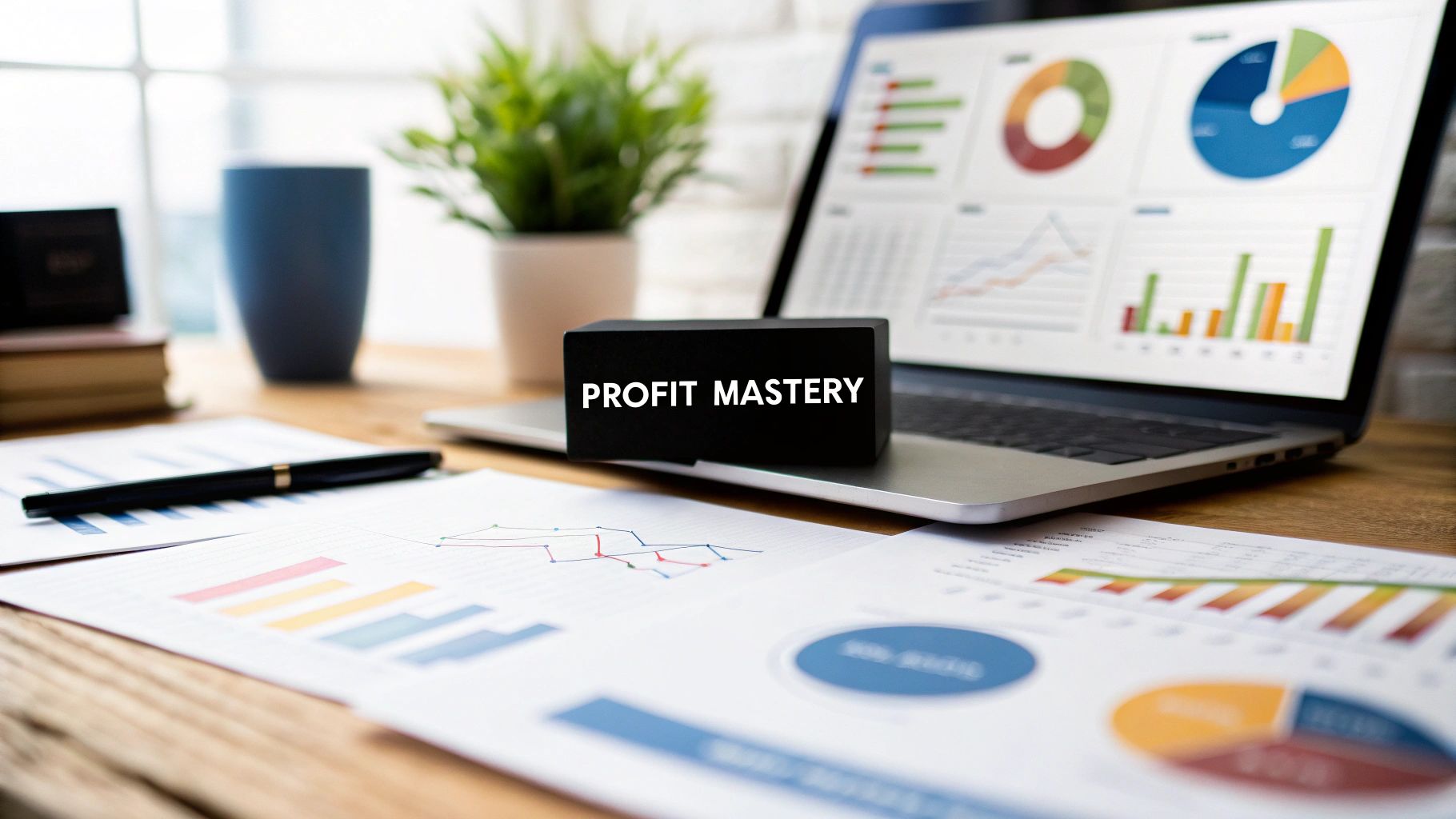Decoding Ecommerce Profit Margins: The UK Landscape
Understanding profit margins is crucial for any UK ecommerce business. It's not just about sales figures; it's about understanding how much revenue contributes to your bottom line. This requires a clear understanding of the differences between gross profit margin, operating profit margin, and net profit margin. Gross profit is revenue minus the direct cost of goods sold. Operating profit subtracts operating expenses like marketing and salaries. Net profit is the final amount after all expenses, including taxes and interest, are deducted. This nuanced understanding is essential for a healthy financial outlook.
Understanding the UK Context
Traditional retail benchmarks can be misleading for online businesses. The UK market has unique dynamics, including higher fulfillment costs, competitive digital marketing, and specific consumer behaviors. These factors create distinct challenges and opportunities for ecommerce businesses. For example, free delivery is often an expectation for UK consumers, impacting margins. The competitive UK ecommerce landscape often necessitates higher spending on online advertising, further affecting profitability. UK businesses must consider these factors when benchmarking their performance.
The UK ecommerce landscape is heavily influenced by sector specialization. The market, projected to reach $141.81 billion by 2025, sees profit margins vary significantly by sector. While accurate UK profit margin data can be difficult to obtain, global benchmarks offer some guidance. Retail sectors, encompassing much of UK ecommerce, generally see gross margins between 21.88% and 34.17%, with food/grocery at 25.54%. Fashion, the dominant UK ecommerce category at 28.7% of revenue, typically follows retail norms, although luxury segments can exceed these. Learn more about UK ecommerce growth at Statista. Post-pandemic growth and current inflationary pressures significantly impact a "good" profit margin for UK ecommerce, making a 20% net profit margin target particularly challenging. See more features on Mergoio's blog.

Navigating the Profitability Puzzle
Simply aiming for a generic “good” profit margin isn't enough for UK ecommerce businesses. Understanding your specific sector and its associated cost structures is vital. Operating costs, particularly fulfillment and digital marketing, significantly impact UK sellers due to market competitiveness and logistical complexities. This makes accurate cost tracking and optimization crucial for sustained profitability. For example, partnering with efficient fulfillment providers and refining marketing campaigns can be powerful tools for improving margins. This highlights the need for detailed, data-driven decisions in the dynamic UK online marketplace.
Real-World Benchmarks: What Profitable UK Retailers Actually Achieve

Let's explore what profit margins successful UK ecommerce businesses actually achieve, moving beyond theoretical ideals. Understanding the diverse online retail landscape is key, as various factors influence real-world profitability. For instance, newer businesses might prioritize growth over immediate high profits, reinvesting to expand market share.
Established businesses, on the other hand, may focus on maximizing profit from existing operations through efficiency. These different approaches significantly impact target profit margins.
Business Maturity and Profitability Goals
Startups often accept lower initial margins to gain traction, concentrating on building a customer base and brand awareness. As a business matures, the focus shifts toward maximizing profits. This transition involves optimizing operations and refining pricing for sustainable profitability. A “good” profit margin is dynamic, evolving with the business lifecycle.
Business Model Impact on Profit Potential
Different business models inherently affect profit potential. Marketplaces like Amazon and eBay offer access to large customer bases but charge fees impacting margins. Direct-to-consumer (D2C) brands require substantial marketing investment but retain greater control over pricing and branding, potentially yielding higher profits. Dropshippers, minimizing inventory costs, frequently trade higher margins for less control over product quality and fulfillment. Recognizing these trade-offs is crucial for evaluating your own business performance.
UK Ecommerce Performance: Navigating Recent Trends
The COVID-19 pandemic (2020) saw UK e-commerce experience a 47% surge in annual sales growth, temporarily boosting margins due to limited brick-and-mortar alternatives. However, 2022 saw negative growth as inflation and supply chain disruptions squeezed margins. While recent data suggests recovery, profit structures remain under pressure. Although gross margins could theoretically reach 45%, actual UK averages likely fall closer to NYU Stern's retail sector average of 21.88%-34.17%. The UK's significant reliance on fashion (28.7% of e-commerce revenue) introduces seasonal margin fluctuations, unlike more stable categories like food (25.54% gross margins). Emerging subscription models and D2C brands could push some UK operators above 20% net margins, though this remains exceptional. For more detailed UK e-commerce statistics, visit Statista.
Sector Performance and Margin Myths
Some sectors consistently outperform the market. Niche retailers specializing in specific products or services often achieve higher margins due to reduced competition and premium pricing. Therefore, a “good” profit margin varies significantly by sector. To provide a better understanding of these benchmarks, let's examine the following table:
To provide a clearer picture of industry benchmarks, let's examine the following table:
UK Ecommerce Profit Margin Benchmarks by Industry
This table presents average gross and net profit margins across different ecommerce categories in the UK, helping businesses understand realistic targets for their specific sector.
| Industry Category | Average Gross Margin | Average Net Margin | Notes |
|---|---|---|---|
| Fashion | 40-50% | 10-15% | Highly competitive, seasonal variations |
| Electronics | 15-25% | 3-7% | Price-sensitive, high competition |
| Beauty & Cosmetics | 50-60% | 15-20% | Strong branding, premium pricing |
| Home & Garden | 30-40% | 7-12% | Growing market, diverse product range |
| Food & Beverage | 25-35% | 5-10% | Perishable goods, logistical challenges |
As this data highlights, "good" profit margins vary significantly by industry. Fashion, while competitive, offers strong potential for high gross margins due to brand premiums. Electronics, conversely, are often subject to tighter margins due to price sensitivity. Understanding your sector's benchmark is key to setting realistic profit targets.
Some common assumptions about profit margins don’t align with real-world data. It's crucial to consider these sector-specific nuances when benchmarking and setting profit targets for your own business.
Category Battlegrounds: Where Profit Margins Flourish or Falter

Not all product categories perform equally in the UK's competitive online marketplace. Understanding the unique profit dynamics of each is essential for setting realistic targets and achieving sustainable growth. For instance, the fashion industry, while potentially lucrative, presents its own set of challenges.
Fashion's Margin Maze: Returns and Revenue
Fashion ecommerce in the UK contends with high return rates, sometimes as high as 40%. This significantly impacts profit margins because returned items incur additional processing and restocking costs.
Effective return management strategies are crucial for mitigating these losses. Moreover, seasonality plays a significant role, necessitating careful inventory planning and strategic promotional timing to maximize profits.
Electronics: Thin Margins, High Volume
Electronics sellers often operate with thin product margins. This makes high sales volume and supplementary revenue streams essential for profitability.
Offering extended warranties or product bundles can improve overall profit. Competition is intense in this sector, underscoring the importance of efficient marketing and pricing strategies.
The Food Fight: Logistics and Perishability
Food delivery and online grocery present unique logistical hurdles. Perishable goods require specialized handling, which increases operational costs.
Maintaining product freshness is also critical, as spoilage can lead to significant losses. Tight inventory control and efficient delivery networks are therefore vital for success in this category.
Niche Markets and Specialty Products: Premium Pricing and Loyal Customers
Unlike high-volume, low-margin categories, niche markets often allow for premium pricing. This is due to specialized products or a highly targeted customer base.
Cultivating a loyal customer base is incredibly valuable in these niches, driving repeat business and ultimately boosting profitability.
The UK Ecommerce Landscape: Fashion, Electronics, and Beyond
The UK's ecommerce profitability is directly tied to the performance of key sectors. Fashion contributes 28.7% of revenue share, followed by electronics at 16.8%. Over 25% of all clothing and footwear sales now happen online.
However, the high return rates inherent in fashion can negate potential gains. Explore further insights on UK ecommerce at Charle. Achieving a net margin above 20% requires exceptional cost control, especially with rising customer acquisition and delivery expenses.
This highlights the importance of category-specific strategies in maximizing ecommerce profitability in the UK. While luxury goods retailers might achieve this target through premium pricing, grocery businesses rely on hyper-efficient logistics to bolster their margins. Understanding these category dynamics is essential for setting realistic profit goals and building a sustainable ecommerce business in the UK.
Margin Killers and Multipliers: What's Really Affecting Your Bottom Line

Several factors beyond the basics can significantly impact profit margins for UK ecommerce businesses. Understanding these "margin killers" and "margin multipliers" is essential for optimizing your bottom line. This involves examining everything from supply chain dynamics to the competitive delivery market.
Navigating Post-Brexit Supply Chain Complexities
Post-Brexit changes have significantly altered cost structures for UK businesses. Increased import duties and logistical hurdles can quickly erode profit margins. Businesses need to explore alternative sourcing options and optimize logistics for greater efficiency. Partnering with UK-based suppliers or establishing more efficient warehousing strategies can help mitigate these challenges.
Taming Skyrocketing Customer Acquisition Costs
Acquiring new customers is expensive. In the competitive UK ecommerce market, marketing costs can quickly escalate. This necessitates a laser focus on efficient marketing strategies. Targeted advertising campaigns, social media marketing, and customer retention initiatives can maximize the return on your marketing spend.
The UK Delivery Landscape: Challenge and Opportunity
The UK delivery market presents both challenges and opportunities. Consumers expect fast and free delivery, but these services cut into margins. Innovative delivery solutions, such as click-and-collect or partnering with local delivery services, can offer a competitive edge while managing costs. Balancing these competing demands requires careful analysis and optimization.
Hidden Margin Eroders: Fees and Inventory
Platform fees, payment processing costs, and inventory management significantly impact margins. Negotiating favorable rates with payment processors and optimizing inventory levels to avoid overstocking or stockouts can help control these often-overlooked costs. Operational efficiency in these areas is key for profitable UK ecommerce businesses. You might also be interested in learning how to manage your website's structure with this helpful resource: How to master your sitemap.
Strategic Advantages of Top Performers
Top-performing UK ecommerce businesses utilize several strategies to maintain healthy profit margins. This often includes dynamic pricing, data-driven inventory management, and focusing on customer lifetime value. This proactive approach helps them adapt to market changes and consistently maximize profitability.
To understand the impact of these factors, let's take a closer look at some key influencers. The following table provides a comparison of these elements, outlining their potential impacts and offering optimization strategies.
Key Profit Margin Influencers for UK Ecommerce
This comparison table highlights major factors that positively and negatively impact ecommerce profit margins, helping merchants identify areas for improvement.
| Factor | Typical Impact on Margins | Control Level | Optimization Strategies |
|---|---|---|---|
| Supply Chain Disruptions | Negative: Increased costs, delays | Medium | Diversify sourcing, optimize logistics |
| Customer Acquisition Costs | Negative: Reduced profitability | High | Targeted marketing, retention strategies |
| Delivery Costs | Negative: Reduced profit per sale | Medium | Negotiate rates, explore alternative solutions |
| Platform Fees | Negative: Reduced overall profit | Low | Negotiate rates, consider alternative platforms |
| Payment Processing Fees | Negative: Reduced profit per transaction | Medium | Negotiate rates, explore alternative providers |
| Inventory Management | Both positive and negative: Overstocking ties up capital, stockouts lose sales | High | Data-driven inventory control, forecasting |
| Pricing Strategy | Both positive and negative: Too high loses customers, too low reduces profit | High | Dynamic pricing, value-based pricing |
| Customer Retention | Positive: Reduced acquisition costs | High | Loyalty programs, personalized experiences |
By carefully managing these factors and implementing the optimization strategies outlined above, UK ecommerce businesses can achieve and maintain a healthy profit margin, even in a competitive market. Understanding the interplay of these "margin killers" and "margin multipliers" is crucial for long-term success.
Profit Amplification: Strategies That Actually Move The Needle
Beyond the fundamentals, let's delve into profit-boosting strategies that yield tangible results for UK ecommerce businesses. These strategies prioritize proactive approaches to pricing, inventory management, customer relationships, and overall operational efficiency. For instance, many leading merchants utilize dynamic pricing to maximize their profits.
Dynamic Pricing: Responding to Demand, Not Competitors
Rather than simply reacting to competitor pricing, dynamic pricing empowers you to adjust prices based on real-time demand, current stock levels, and even the time of day. This approach can substantially improve profit margins, especially during peak seasons or for high-demand products. Imagine a sought-after toy during the Christmas rush. Dynamic pricing allows you to capitalize on the surge in demand while simultaneously ensuring you don't lose sales due to underpricing.
This flexibility allows businesses to optimize their pricing strategy in response to market fluctuations and consumer behavior.
Inventory Optimization: Reducing Costs, Improving Availability
Effective inventory management is paramount. Excess stock ties up valuable capital and incurs storage costs, while stockouts inevitably lead to lost sales and disappointed customers. Inventory optimization involves leveraging data to accurately forecast demand. This ensures you have the right products available at the right time, minimizing storage expenses and maximizing sales opportunities. This creates a balance between supply and demand, contributing to optimal profitability.
Accurate forecasting helps businesses avoid the pitfalls of overstocking or understocking, leading to improved cash flow and customer satisfaction.
Customer Retention: Lowering Acquisition Costs, Building Loyalty
Acquiring new customers can be expensive. Focusing on customer retention offers a more cost-effective path to improving profit margins. Loyalty programs, personalized marketing, and exceptional customer service cultivate strong customer relationships. This encourages repeat business and reduces reliance on costly customer acquisition campaigns. Think of it as investing in a long-term relationship rather than a series of first dates.
Building customer loyalty fosters a sustainable revenue stream and strengthens brand advocacy.
Smart Product Bundling: Creating Margin Opportunities
Product bundling involves strategically grouping complementary items and offering them at a slightly discounted price compared to purchasing each item individually. This encourages larger orders, increasing the average order value and boosting overall profit. For example, a retailer selling phone accessories could bundle a phone case, screen protector, and charger at a combined price that's appealing to customers while generating higher margins than selling each item separately. Check out our guide on how to master your product listings for additional insights.
Fulfillment Optimization: Transforming Profitability
Efficient fulfillment significantly impacts profitability. Streamlining your warehouse operations, negotiating favorable rates with carriers, and optimizing delivery routes can reduce costs without sacrificing speed or reliability. Furthermore, offering click-and-collect options can further minimize shipping expenses and enhance convenience for customers.
Operational Automation: Streamlining for Efficiency
Automating repetitive tasks, such as order processing, inventory updates, and customer service responses, liberates your team to focus on higher-value activities that directly contribute to profit growth. This not only enhances efficiency but also reduces the likelihood of errors, leading to further cost savings and improved customer satisfaction. By implementing these combined strategies, businesses can address the question of what constitutes a good profit margin for ecommerce in the UK and build a profitable and sustainable online enterprise.
Measuring What Matters: Tracking Ecommerce Profit Like A Pro
Transforming your profit margins starts with measuring the right metrics. Simply knowing your revenue isn't enough. You need a precise understanding of your profitability metrics: accurately calculating and monitoring your gross, operating, and net profit margins. For example, high revenue can be misleading if your operating costs are equally high, resulting in a low net profit.
Key Performance Indicators: Beyond the Basics
Understanding your core profit margins is fundamental. However, other key performance indicators (KPIs) offer valuable early warnings of margin compression.
-
Average Order Value (AOV): Tracking AOV helps identify trends in customer spending. A declining AOV might suggest implementing upselling or cross-selling strategies.
-
Customer Acquisition Cost (CAC): Knowing your CAC is essential. A rising CAC can quickly erode profit margins, meaning you need to evaluate your marketing campaigns' effectiveness.
-
Return Rate: High return rates, especially common in the UK fashion market, significantly impact profitability. Processing returns adds extra costs. Monitoring return rates helps pinpoint issues with product quality or sizing.
Cost Allocation: A Critical Piece of the Puzzle
Accurately allocating costs across products and channels is essential for informed decision-making. This means understanding your most profitable products and sales channels. For instance, if you sell on multiple platforms, accurately attributing costs like platform fees and marketing spend is vital for understanding true profitability per channel.
Analytics Tools: Seamless Integration for UK Businesses
Several analytics tools integrate seamlessly with popular UK ecommerce platforms, simplifying profit tracking. Choosing the right tool can automate data collection and reporting, saving you valuable time and effort, allowing you to focus on improving margins.
Business Model Specifics: Tailoring Your Approach
Different business models require tailored reporting. For example, a dropshipping business has different cost structures than a D2C brand. Understanding your specific business model is crucial for accurate profit analysis.
Common Accounting Mistakes: Avoiding Pitfalls
Certain accounting errors can lead to misleading profitability insights. Incorrectly classifying expenses, for example, can distort your profit margins. A robust accounting system and professional advice are crucial.
Dashboarding: Keeping Margin Management Front and Centre
Creating clear and concise dashboards keeps margin management top-of-mind. A well-designed dashboard provides a snapshot of key profitability metrics, enabling quick identification of areas needing attention.
Tracking these metrics effectively allows you to pinpoint areas for improvement and make data-driven decisions that positively impact your bottom line. Stop guessing and start knowing with a profit tracking solution tailored to your needs.
Ready to take control of your ecommerce profitability? Mergoio offers a comprehensive dashboard and real-time analytics designed for TikTok Shop sellers, providing a detailed view of your sales and profit. With features to track individual product performance, understand tax implications, and even predict affiliate costs, Mergoio empowers you to make data-driven decisions that boost your bottom line. Sign up today and experience the difference: https://mergoio.com

Leave a Reply